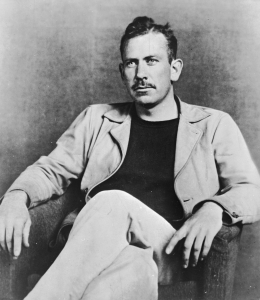
"Literature is as old as speech. It grew out of human need for it, and it has not changed except to become more needed." — from John Steinbeck's Nobel Prize speech
The California farm town of Salinas welcomed John Steinbeck into the world on February 27, 1902, but the welcome eventually wore out. From an early age, his schoolteacher mother imparted a love of learning and language. From his bankrupt father, Steinbeck acquired a hypersensitivity to social nuances, a profound empathy for the underprivileged, and a strong work ethic that rarely left him. After receiving his diploma from Salinas High in 1919, he alternated work as a field hand with sporadic attendance at Stanford University.
His fourth novel, Tortilla Flat (1935), made his name as a writer. Then, drawing on his strengths—deep regard for his native California and empathy for his fellow hard workers—Steinbeck spent years researching and a miraculous five months writing The Grapes of Wrath. Published in 1939, it won him the National Book Award, the Pulitzer Prize for fiction and decades of enmity from his hometown, where he was viewed as a traitor to his (middle) class.
In a span of three months between 1939–1940, critically and commercially successful films of both The Grapes of Wrath and the short novel Of Mice and Men came out. During World War II, the New York Herald Tribune signed him on as a war correspondent and he filed dispatches from England and the Mediterranean.
After the war, Steinbeck left California for New York and cast around for a subject that would engage him as fully as The Grapes of Wrath had. He divided his attention among science writing, journalism, screenplays, and shorter novels. Finally, in 1952, following the collapse of his second marriage and the sudden death of his beloved friend, marine biologist Ed "Doc" Ricketts, Steinbeck wrote his way imaginatively back to California for East of Eden, among his strongest and most enduring novels.
The 1962 memoir Travels with Charley freshened and deepened Steinbeck's already wide readership. The highest honors were given to him: the Nobel Prize for literature in 1962, the Presidential Medal of Freedom in 1964, and appointment to the National Council on the Arts in 1966.
Steinbeck died in New York City in 1968 and was buried with little fanfare in Salinas. Today, the handsome National Steinbeck Center anchors Salinas's downtown revival, complete with research library and a museum featuring the original camper truck from Travels with Charley. Migrants still pick most of the fruit in California's Central Valley, but they come from Central America instead of Oklahoma, and agriculture has a new partner driving the region's economy: literary tourism. — Courtesy NEA Big Read
Read the National Steinbeck Center's extended John Steinbeck biography and timeline.















